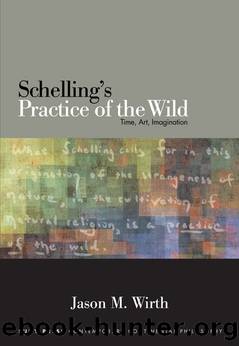Schelling's Practice of the Wild by Wirth Jason M

Author:Wirth, Jason M.
Language: eng
Format: epub
Publisher: State University of New York Press
Published: 2015-11-14T16:00:00+00:00
Transformational masks express the living temporality of plasticity. âPlasticity thus appeared to me from the outset as a structure of transformation and destruction of presence and the presentâ (PDW, 9). The carnival is the temporal progression of masks, endlessly unfolding layers of divine personae without God being something beneath the masks, but rather the dynamically productive excess of their visibility, the dark mother of gravity.19
We could now say that just as nature is not only naturata (the clarity of what is), but also the productivity of natura naturans (nature producing itself anew), art is not just the catalog of artworks and techniques, but also the miracle of art. Nature natures and art arts!
At the beginning of the Munich speech, Schelling argues that the ârelationshipâ between nature and the Bilder of art, the plasticity or shaping into form brought forth in die bildende Kunst, is located in a âliving centerâ that holds art and nature together. âThe plastic arts therefore stands manifestly as an active copula [Band] between the soul and nature and can only be grasped in the living center between both of themâ (I/7, 292). What is this living center that governs the relationship between ÏÏÏÎ¹Ï and ÏÎÏνη, nature and art? How do the images of nature relate to the images of art? The living center is the imagination itself. As we see in greater detail in the following chapter, the life of die Bilder is the productivity of Einbildungskraft.
The latter already literally speaks of the sovereign introduction (ein) of image (Bild) into that which is at first without image. Schelling sometimes spoke of this âexpulsive [ausstoÃende]â movement as the In-Eins-Bildung (e.g., I/7, 60), that is, the conjunction of soul and form as a saturated production. The many become one (Eins) through have coming into (In) form (Bild). Coleridge, for his part, attempted to render this movement through his remarkable neologism âesemplastic,â derived from the Greek âÎµÎ¹Ï ÎµÎ½ ÏλάÏÏειν, that is, to shape into one. â¦â The shaping is âplasticâ (from ÏλάÏÏειν), suggesting the unified and unifying movement from the formless to the formed. As Coleridge reflected: âI constructed it [the word âesemplasticâ] myself from the Greek words, ÎµÎ¹Ï ÎµÎ½ ÏλάÏÏειν, i.e., to shape into one; because, having to convey a new sense, I thought that a new term would both aid the recollection of my meaning, and prevent its being confounded with the usual import of the word, imagination.â20 The relationship between the plastic arts and nature is the plasticity of the esemplastic itself.
When I repeat the movement of the imagination as if I were simply reproducing something I once saw as if it were secondhand version of the same thing, art is lost and representation prevails. (It was the genius of Proust to demonstrate that remembering is creative.) Kitsch, to use a term made famous by Hermann Broch, has a murderous relationship to nature. Kitsch is not, as Broch insisted, bad art, but rather pseudo-art, something nonartistic trying to pass itself off as art. As such, Broch concluded, kitsch is an experience of radical evil.
Download
This site does not store any files on its server. We only index and link to content provided by other sites. Please contact the content providers to delete copyright contents if any and email us, we'll remove relevant links or contents immediately.
The Lonely City by Olivia Laing(4568)
Animal Frequency by Melissa Alvarez(4148)
All Creatures Great and Small by James Herriot(3986)
Walking by Henry David Thoreau(3681)
Exit West by Mohsin Hamid(3634)
Origin Story: A Big History of Everything by David Christian(3472)
COSMOS by Carl Sagan(3346)
How to Read Water: Clues and Patterns from Puddles to the Sea (Natural Navigation) by Tristan Gooley(3239)
Hedgerow by John Wright(3106)
How to Do Nothing by Jenny Odell(3101)
The Inner Life of Animals by Peter Wohlleben(3099)
How to Read Nature by Tristan Gooley(3077)
Project Animal Farm: An Accidental Journey into the Secret World of Farming and the Truth About Our Food by Sonia Faruqi(3018)
Origin Story by David Christian(2991)
Water by Ian Miller(2950)
A Forest Journey by John Perlin(2915)
The Plant Messiah by Carlos Magdalena(2745)
A Wilder Time by William E. Glassley(2689)
Forests: A Very Short Introduction by Jaboury Ghazoul(2671)
